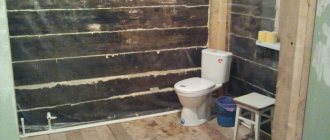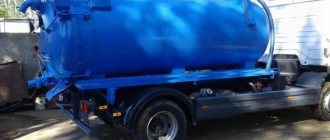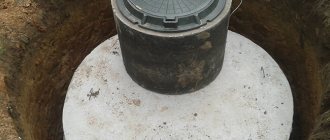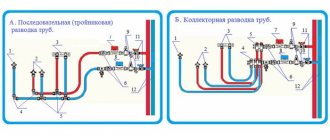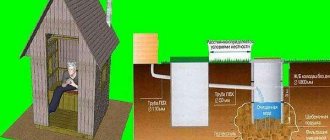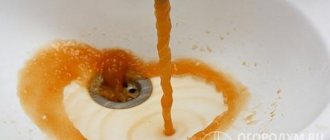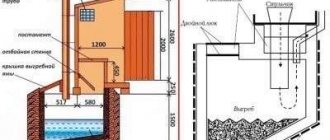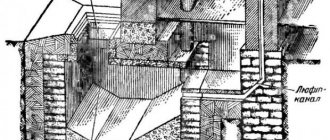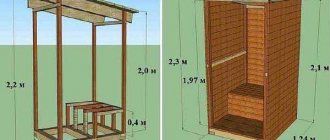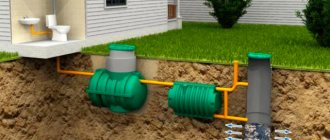Even the simplest type of sewage system with a cesspool can significantly increase the level of comfort in a suburban area. However, this solution has a significant disadvantage - the container for the accumulation and primary processing of wastewater requires periodic removal of the contents. Agree, cleaning of cesspools must be carried out according to the rules so that no damage is caused to the environment.
For owners of private houses and summer cottages not connected to centralized sewer networks, we offer scrupulously verified, systematic information about the methods and specifics of cleaning. With our help, you will be able to choose the best option for disposal of wastewater accumulations and learn how to implement it.
A detailed description of the methods used in practice is based on the personal experience of household owners. The requirements of utility standards are taken into account. The information is confirmed by photo and video applications.
Cleaning cesspools and toilets - how to understand that the pit needs to be cleaned
A cesspool is usually represented by a sealed tank. This means that all wastewater is mostly retained in the tank. To prevent the contents from overflowing beyond the walls, inspection wells or doors are provided. Pumping occurs through them. The acceptable filling rate is considered to be ⅔ of the total volume.
In addition to visual analysis of the situation, there are three signs indicating that the reservoir is full:
- the flow of water from plumbing equipment (sink, bathtub, toilet) slows down;
- gurgling sounds are heard in sewer pipes;
- a characteristic smell appears in the house and yard.
Partial liquid seeps through the bottom and walls and goes into the ground.
But the ducts become clogged with solid particles, so you need to periodically monitor the fullness of the pit and clean it in a timely manner. There may be an obstacle to the natural filtration of wastewater in the form of silt formations.
The reason for their appearance is incomplete or rare removal of sediment from the cesspool.
Causes and symptoms
Before figuring out how to clean a cesspool of sludge, you should understand why the pollution occurred and, of course, know how to recognize it.
Causes
The key reason that a cesspool or septic tank silts up is improper operation. As a result of the fact that the containers are not emptied on time, grease settles on the walls, which complicates the filtration process. This problem is especially noticeable in cesspools, since the walls of such a collector and the bottom filter the wastewater. If problems arise with this, the user has to clean the pit much more often.
Important! Another problem why a cesspool fills up quickly is the lack of bacteria that process sludge. If they are not brought into the cesspool at all, it will silt up very quickly.
Bacteria perform very important functions, including:
- Liquefaction of sludge, reducing its volume, helps prevent silting of the walls and bottom.
- Bacteria remove unpleasant odors.
- They clean the inside of the pipeline.
- The structure of the soil becomes porous, which facilitates the removal of liquid from the pit.
Important! Experienced people recommend not pumping out the cesspool until the last moment, since the more liquid there is, the greater the pressure on the walls and bottom, the more likely it is that water and sewage will seep into the soil. At the same time, after the first pumping, the remaining sludge dries on the walls and bottom of the pit and clogs the liquid seepage paths.
Remember! After the first pumping of the cesspool, its ability to filter and drain liquid will decrease sharply! You will have to increasingly call sewer trucks for pumping.
Signs
It is quite easy to understand that a drainage pit or septic tank has silted up; signs of this process:
- The useful volume has decreased.
- The pit is filling up much faster than before.
- You can notice fatty accumulations on the walls - this also reduces the volume, moreover, it prevents waste from passing through the walls.
- A sharp, unpleasant odor appears. Of course, the smell will be there in any case, but if it hurts your nose too much, you should figure out what the problem is.
- The layer of silt can be seen from the inspection hatch.
The designs of a cesspool and a septic tank are different, but the latter often suffers from siltation, in particular the wastewater settling chamber. The septic tank will quickly signal a problem if you regularly inspect the installation through the inspection well.
This is interesting: Do-it-yourself insulation of external sewer pipes
How to clear sludge from a cesspool
The presence of silt limits the natural flow of water from the pit. Sediment also causes deposits, which eventually turn into a hard crust. It will be difficult to get rid of the latter. Therefore, the contents must be eliminated, and then work is carried out with the sludge formation.
DIY option
Do-it-yourself cleaning is done using a scraper or brush with metal bristles. The contents are disposed of, and the bottom and walls are washed with running water. It is worth being prepared in advance for a lot of dirt. Nitrate oxidizers can help in the fight, but care must be taken with chemicals.
With pump
Here you will need a drainage or fecal pump, a brush with metal bristles and a container to pump out the sediment. You also need a hose to transport the mass. It is connected to the installation.
The depth of its immersion depends on the type of pump: to the bottom or to the wastewater level. It is recommended to take a fecal pump with a grinder.
First, liquid waste is pumped out. Next, mechanical cleaning of the bottom and walls is carried out. The contents are pumped out again. After filling the hole with water, the procedure is repeated.
Some valuable recommendations
If problems with the cesspool begin to occur more often, it makes sense to improve the operation of the structure in accessible ways. Some install a cesspool with an overflow, which functions like a septic tank. To do this, next to the existing container, they arrange another one, approximately the same.
The first container should be sealed, and the second should be permeable or without a bottom. It is possible to make the second container airtight, but then provision should be made for the juices to be discharged to a filtration field or to a drainage well. The overflow between these two sections is installed with a slight slope in the upper third of the containers.
First, the wastewater will flow into the first compartment, where it will settle, solid waste will sink to the bottom, and the liquid component of the sewer content will overflow when it reaches the desired level.
The second compartment will receive mainly liquid waste, which will quickly move to the filtration field for further disposal. As a result, the pit will have to be cleaned much less frequently, and the likelihood of siltation of the structure will noticeably decrease.
Freezing of sewer pipes occurs most often due to flaws during installation. If this happens, the pipe needs to be heated to restore the sewer system.
In winter, the drainage in the cesspool may freeze, which will lead to problems in the operation of the sewerage system. To correct the situation, the frozen mass must be thawed. Traditionally, a heat gun or its homemade equivalent is used for this. If there is no power supply, fires are lit next to the frozen pit, a blowtorch is used, etc.
For craftsmen who have at least a little experience working with electricians, another method of defrosting a cesspool is available - heating directly using electric current. A metal pin is driven into the middle of the frozen cesspool to approximately the freezing depth.
Then you need to take an electrical cable of a suitable length. Its end is stripped and connected to the pin, and 220V power is supplied to the opposite end.
It may take quite a lot of time to completely defrost the structure, sometimes you need to wait about a day, it all depends on the size of the pit. When performing this type of work, it is imperative to comply with electrical safety requirements, for example, use protective rubber gloves, shoes, etc.
If it is not the pit that freezes, but the sewer pipe leading to it, this indicates flaws in the laying of communications, for example, the trench was not deep enough or there is no insulation. These problems can be corrected in the summer, but during cold weather, care should be taken to defrost the pipes.
Electric current can also be used for this. At the end of the cable you need to strip a section equal to the circumference of the pipe. To calculate this value, you simply need to multiply the pipe diameter by 3.14, i.e. to the number “pi”.
The protected wire is then wound around the frozen pipe. Power is supplied to the cable; after a couple of hours of such heating, the contents of the pipe will melt and the operation of the sewer system will resume.
Cleaning the pit with folk remedies
The question often arises of how to clean a cesspool without pumping using folk remedies. This is especially true when the tank is small. To pump it out, renting a car and sewage disposal equipment is unreasonably expensive.
Here are some solutions from resourceful villagers and summer residents:
- Wood sawdust. The mass of natural fibers perfectly absorbs water, gases and partially odors. Phytoncides contained in conifers help neutralize the effects of pathogenic bacteria.
- Nettle. The main active ingredient here is oxalic acid. It enters into a chemical reaction with organic matter, due to which wastewater is disinfected.
- Tops, mint and basil. The first include shoots of potatoes, peppers, and eggplants. They have antiseptic properties, eliminate odors, as they slow down the development of microorganisms.
To achieve greater efficiency, you need to use sawdust of a minimum size.
Natural remedies contribute to the formation of safe raw materials for compost. But they do not completely exclude tank cleaning. If the liquid partially leaves and evaporates like a gas, then solid residues remain. You can remove them yourself by scooping out the contents or hire a car.
For preventive measures to prevent sewer pipes from becoming coated with grease, you can purchase “mole” or other chemicals. Another option involves using baking soda and vinegar. The mixture additionally eliminates odor.
How to avoid the formation of growths on the walls of the pit
Build-ups form from silt and settling fats. Prevention of this phenomenon is that the walls and bottom need to be cleaned and rinsed with water after removing the contents. There are also biological and chemical types.
Available drugs
One of the effective means for caring for septic tanks is called “Doctor Robik 309”. This is a professional composition, the action of which is based on the activity of microorganisms. Result: dissolution of fats and organic matter, elimination of odor. The liquid is shaken and poured into the toilet or pit once a year. It is not advisable to use water during the day. You can empty the drain tank in advance.
The Polish biological activator Septifos Vigor in powder form can be a regular means of reducing the volume of wastewater. The calculation is based on a dose of 25 grams per cubic meter. meter. The toilet is backfilled once every 10 days. A 1.2 kg package lasts approximately 7 months. The first portion should be double. This way it will be possible to clean the pit only after 10-12 years.
Classification by type of action
Depending on the active components, there are remedies:
- Chemical;
- Biological.
Chemical drugs differ from biological ones in their versatility. They dissolve feces in any conditions (at any temperature and type of waste). They are suitable for use in the cold season and any type of septic tank.
Chemical solution for cesspool
They are classified according to the active components of the mixture. Nowadays mixtures with formaldehyde, ammonium salts and nitrates are actively used. The latter are considered the safest for the environment. But quaternary ammonium compounds are the most effective - they completely neutralize the unpleasant odor from the septic tank and eliminate old feces.
Ammonium salts
These funds have their advantages and disadvantages. Among the advantages it is worth highlighting:
- Versatility;
- Possibility of use in conditions of hard water, soap solutions and other additives;
- High efficiency. Preparations of this kind perfectly clear even complex blockages, dissolve long-term sediments on the walls of septic tanks and pits, and eliminate unpleasant odors in a short time.
Of the minuses:
- Low environmental friendliness. Water purified using chemical elements cannot be used as technical water. In addition, chemical compounds through open septic tanks or leaky areas can be absorbed into the soil or enter groundwater;
- Even after such cleaning, over time it will be necessary to carry out sewage pumping. Chemically purified liquid contains numerous pathogenic compounds that will negatively affect the quality of the soil. Its fertility may decrease and its structure may change. Therefore, such water must be removed from the site;
- When exposed to certain solutions, metal and plastic connections may
Biological means for cleaning cesspools are affordable and effective preparations for getting rid of unpleasant odors and wastewater. They consist of bacteria and organic additives, which for some time serve as a habitat for microorganisms. These bacteria process waste and are therefore completely safe to use.
Interaction between anaerobic and aerobic bacteria and air
Biological agents are also divided into:
- Anaerobic;
- Aerobic.
Video on the topic:
Anaerobics do not require oxygen. Such connections are suitable for cleaning sealed closed septic tanks, as well as pipes. Aerobic “work” only in the presence of fresh air, since their activity directly depends on the level of oxygen in a certain environment.
Bacteria for the cesspool
Advantages of using biological additives:
- Complete elimination of unpleasant odors and old waste. Despite the fact that biological additives take much longer to clean cesspools than chemical compounds, they are no less effective;
- Safety. Microorganisms not only clean wastewater from solid particles and liquid residues, but also saturate them with organic substances. This allows this water to be used in the future for irrigation of fields or fertilizers;
- Suitable for use in metal and plastic barrels. Bacteria do not corrode walls and joints and are safe for rubber couplings;
- Enzyme formulations are quite accessible and characterized by a prolonged action.
The disadvantages include:
- Impossibility of use in the cold season. When the temperature drops below 10 degrees, bacteria become less active, which reduces cleaning efficiency;
- There are only a few dietary supplements that can be used to clean shower, bath, or chlorinated water drains. In most cases, microorganisms react negatively to the presence of chemical impurities in wastewater. In such an environment, they stop reproducing and then simply die;
- Depending on the type of biological means for cleaning cesspools, it is necessary to maintain a certain level of oxygen. Aerobic bacteria are considered more active than aerobic bacteria, but when introducing them, a certain oxygen level inside the pit must be maintained.
Remember that when using biological additives, mineral deposits fall to the bottom of the container. This is not sludge, but they also require disposal, otherwise the useful volume of the reservoir is reduced.
Cleaning with a vacuum cleaner
There are offices that deal with issues of cleaning septic tanks and cesspools using a sewer truck. In 2-3 hours, the tank is completely emptied with possible removal of silt deposits. The Contractor also carries out waste removal and disposal.
What you need to know
Before ordering a car, you should find out the size of the cesspool. The cost of the work will depend on the volume of filling the technical tank. For a large septic tank, you may need a large tank or you will have to pump out the wastewater in 2 passes.
When to clean your drive
The contents of a cesspool are a mixture of human waste products, food waste, used water and other organic residues.
In the reservoir into which they enter, chemical and biological transformations occur. Processes of oxidation, fermentation, and decay occur. This produces gases that are harmful to humans and the environment. Liquid waste penetrates into the deep layers of the soil and poisons it through the water cycle.
For this reason, the use of cesspools without a bottom is strictly prohibited. This causes irreparable harm to the environment.
Old-type cesspools are cleaned of sewage using special vacuum trucks.
- To operate such a machine, it is necessary to provide an access road and free access to the waste storage area.
The cleaning procedure using special equipment is justified only if it is necessary to empty a large container. Because this is not a cheap service. Its cost includes not only the operation of the car, but transportation and disposal of hazardous waste.
There are other ways to make cleaning cheaper.
Recently, structures for this purpose have been put into operation subject to the construction of a special tank with the use of biologically active drugs. They process organic waste into safe chemical compounds. This system is called a “septic tank”.
Special substances designed for modern sewers can also be used for conventional cesspools. Their use will significantly reduce the number of pumpings. But you still have to do it.
How often to clean depends on the size of the storage tank and the amount of waste received. For example, a tank with a volume of 2 m
3
, which is used regularly by a family of three, requires cleaning every two years. The maximum possible period without waste disposal is 10 years. But, it is better to empty the tank every year than to pump out a large volume of sewage that has accumulated over several years.
Sanitary standards for the construction of a septic tank
Before choosing a place for future sewerage, you need to familiarize yourself with the sanitary standards for a septic tank. This is a list of some documents in accordance with which construction must be carried out. The main document that should be used to guide the construction of such structures is SNiP 2.04.03-85. This regulatory document regulates the construction of sewers. If water will be supplied to the house from a well or borehole, then compliance with SNiP 2.04.01-85 and 2.04.04-84 will also be required.
Sanitary standards (SanPiN 2.1.5.980-00) regulate sanitary requirements, the main task of which is to maintain the purity of water located on the surface. Since the septic tank is considered a potentially dangerous area, it is also subject to regulation by SanPiN 2.2.1/2.1.1.1200-03.
Distance to well
You should choose a location for a treatment facility not only based on your own preferences, but also in compliance with standards. The fact is that in the event of an emergency, wastewater can get into drinking water if there is a well or borehole nearby. Water pollution can cause illness or even death. Even though modern treatment plants have durable, sealed casings, pipe rupture or depressurization cannot be ruled out. Therefore, you should choose the greatest possible distance to the nearest body of water.
The standards state that the choice of distance from a well or borehole to a treatment plant will primarily be influenced by the type of soil on the site. If there are filter layers that can filter wastewater in the event of force majeure, then the distance can be reduced.
Getting permission
Cesspools and septic tanks can cause harm to the environment, so they should not be built uncontrolled. Before preparing the project, be sure to contact the SES and obtain the necessary permission. Only after it is given to you and the project is approved, you can begin construction of the structure. A permit will not be issued if the construction does not comply with the sanitary rules and building codes that are in force at the time of the creation of the project.
Prevention
In order not to encounter the problem that water does not drain from the cesspool, regular preventive maintenance should be carried out, namely:
- Fill the hole that begins to silt with water to dissolve the sediment.
- Use biological preparations on a regular basis that are gentle and at the same time eliminate siltation.
- Carry out timely pumping of liquid masses.
- Rinse the pit at least once a month with clean water.
If waste stagnates in a cesspool or septic tank, it is likely to form sludge. In addition, in such an environment bacteria and pathogenic microorganisms, which are dangerous to humans and surrounding living beings and plants, successfully multiply. It is better to prevent siltation than to deal with it later.
Summarize
Of course, cleaning sewer pipes with ordinary baking soda is much inferior to the technology of using special reagents, but it always gives a positive effect. Therefore, we should not forget about it. After all, caustic soda is not always available, but soda, vinegar and salt can always be bought in the store.
Plastic and steel pipes are cleaned using these methods. They can also be used for preventive maintenance.
Let us immediately note that caustic soda is very different from baking soda, although ordinary baking soda can be effectively used to clean drains. Caustic copes with the same tasks much more effectively, but it can only be fully used for cleaning metal sewer pipes. If a section of pipes replaced with plastic gets in the way of cleaning, they may be damaged.
The use of strong alkalis and acids intended to remove blockages in metal pipes on plastic sewers is undesirable.
Optimal container sizes
In order to return to the issue of cleaning as rarely as possible, it is worth calculating the size of the drive in advance. Based on average statistical data, the volume of daily human waste products is 300-500 g per day. That is, per year from 100 kg to 180 kg. To this figure you need to add the amount of water used for washing food and household needs if the drainage system from the house is connected to pipes leading to a cesspool. That is, everything that goes down the drain.
The liquid entering the collector evaporates, but heavy waste remains and settles to the bottom. They are the ones that need to be removed from time to time. So it turns out that the larger the storage capacity, the less often it needs to be emptied.
- The larger the volume of the waste container, the procedure for emptying it
We arrange the removal of clarified wastewater
If you have problems with a septic tank overflowing, which can no longer withstand the increased number of consumers, then you will have to either build a drainage well or equip a filtration field.
No drugs can solve the problem of insufficient septic tank capacity. If the daily water discharge exceeds 1/3 of the volume of the sump, then the construction of a well or filtration field is an almost inevitable step, the only alternative to which would be to dismantle the old septic tank and install a new treatment plant.
Drainage well
The basis of such a structure is a shallow shaft of 3-4 meters, dug to sandy soil layers. Usually it comes off at a distance of up to 5 meters from the septic tank and is connected to the sump tank by a separate pipeline with a diameter of 110-150 millimeters. The pipe must go at a slope (towards the well), with a height difference of 2 centimeters per linear meter of line.
The walls of the drainage well are reinforced with concrete rings, the bottom of which will have to be perforated by drilling many holes with a diameter of 15-20 millimeters in its body. Clarified water from the septic tank overflows into the well and goes into the sandy soil horizon.
An alternative option is a drainage well made of polymer, assembled by 2-3 people from plastic parts (bottom, ring with pipe outlets, telescopic neck).
Filter field
This is a larger-scale system consisting of a perforated pipeline buried a meter into the ground. Moreover, the perforated pipes are laid on a sand and gravel bedding with a thickness of 25 centimeters and covered with the same mixture.
Arrangement of the filtration field involves digging a trench, placing bedding at its bottom and laying pipes. After assembling the pipeline, it is covered with a 20-centimeter layer of sand and gravel backfill. Finally, the trench is filled with selected soil.
The filtration field pipeline runs at a slope of 2.5 centimeters per linear meter, so the depth of the trench can vary from 1 to 1.5 meters. As a rule, at least 8 linear meters of the filtration field pipeline are allocated per user, so owners of large-volume septic tanks dig not one trench, but several, placing 5 or 10-meter sections parallel to each other.
Diluting soda to flush the sewer pipe system
As mentioned earlier, there are three types in which this product is produced - liquid in the form of a gel or solution, solid in the form of a powder. “Mole” is purchased at a hardware store in a ready-made form, and pouring the solid substance into pipes is strictly prohibited; it must first be diluted. To do this, you will need 3-4 kg of soda, a device in the form of a spatula or scoop, and a metal or plastic container that will not be destroyed by the powder, since it is quite caustic.
To avoid damaging the skin of your hands, it is recommended to wear gloves, and to prevent the solution from getting on the mucous membranes, wear glasses. Pour the entire amount of soda bicarbonate with water in the amount of 7-7.5 liters of water and stir until it is completely dissolved. When combined with a liquid, the alkali begins to release a large amount of heat into the environment, so you need to know that the bucket with all its contents will heat up and may even become hot.
Signs of siltation
The most striking sign of siltation at the bottom of the cesspool is a decrease in the volume of the tank. Subsequently, the rate of filling of the waste tank increases, and the need for frequent pumping arises. The second “symptom” is the accumulation of fatty deposits on the walls. They also reduce the volume of runoff and interfere with the normal settling of waste.
Silting of the waste tank
Other signs of siltation:
- Presence of a strong, unpleasant odor. Naturally, a certain stench will emanate from the cesspool, but if it manifests itself particularly clearly, then the sludge deposits urgently need to be eliminated. Such a stench signals slow decay processes;
- A layer of silt is visible from the inspection hatch. This is a clear sign indicating the need for immediate cleaning of the pit.
Sludge in a cesspool
Scope of application of sodium hydroxide
Basically, this is the elimination of severe contamination, since the product effectively dissolves dirt, fat accumulation, soot, carbon deposits, and oil stains. Alkaline properties are used to neutralize acidic wastewater. Thanks to these properties, the product is effectively used for cleaning sewage drains; it perfectly dissolves organic components contained in contaminants; soda copes with all this without difficulty.
You can do this cleaning yourself without much difficulty; you don’t need any special skills for this. You just need to pour the product into the pipes and wait a certain time, then rinse with running water for several minutes, repeat the procedure if necessary.
Features of gas connections
When connecting gas stoves, water heaters and other types of equipment, flexible hoses are also used. Unlike water models, they are yellow and are not tested for environmental safety. For fixation, end steel or aluminum reinforcement is used. There are the following types of devices for connecting gas appliances:
- PVC hoses reinforced with polyester thread;
- made of synthetic rubber with stainless steel braid;
- bellows, made in the form of a corrugated stainless steel tube.
The Santekhkomplekt holding offers engineering equipment, fittings, plumbing fixtures and devices for connecting them to communications. The assortment is represented by products and materials from well-known foreign and domestic manufacturers. Discounts apply for bulk purchases, and product quality is confirmed by standard certificates. For information support and assistance, each client is assigned a personal manager. The ability to arrange delivery within Moscow and to other regions of the Russian Federation allows you to quickly receive the purchased goods without unnecessary hassle.
